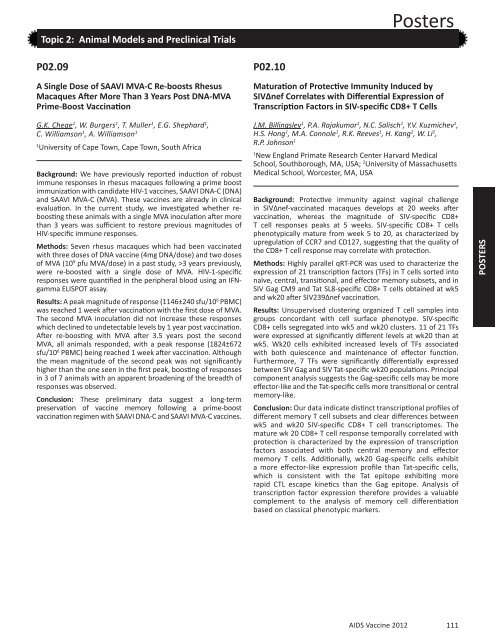Oral Abstract Session 01 - Global HIV Vaccine Enterprise
Oral Abstract Session 01 - Global HIV Vaccine Enterprise
Oral Abstract Session 01 - Global HIV Vaccine Enterprise
You also want an ePaper? Increase the reach of your titles
YUMPU automatically turns print PDFs into web optimized ePapers that Google loves.
Topic 2: Animal Models and Preclinical Trials<br />
P02.09<br />
A Single Dose of SAAVI MVA-C Re-boosts Rhesus<br />
Macaques After More Than 3 Years Post DNA-MVA<br />
Prime-Boost Vaccination<br />
G.K. Chege 1 , W. Burgers 1 , T. Muller 1 , E.G. Shephard 1 ,<br />
C. Williamson 1 , A. Williamson 1<br />
1 University of Cape Town, Cape Town, South Africa<br />
Background: We have previously reported induction of robust<br />
immune responses in rhesus macaques following a prime boost<br />
immunization with candidate <strong>HIV</strong>-1 vaccines, SAAVI DNA-C (DNA)<br />
and SAAVI MVA-C (MVA). These vaccines are already in clinical<br />
evaluation. In the current study, we investigated whether reboosting<br />
these animals with a single MVA inoculation after more<br />
than 3 years was sufficient to restore previous magnitudes of<br />
<strong>HIV</strong>-specific immune responses.<br />
Methods: Seven rhesus macaques which had been vaccinated<br />
with three doses of DNA vaccine (4mg DNA/dose) and two doses<br />
of MVA (109 pfu MVA/dose) in a past study, >3 years previously,<br />
were re-boosted with a single dose of MVA. <strong>HIV</strong>-1-specific<br />
responses were quantified in the peripheral blood using an IFNgamma<br />
ELISPOT assay.<br />
Results: A peak magnitude of response (1146±240 sfu/106 PBMC)<br />
was reached 1 week after vaccination with the first dose of MVA.<br />
The second MVA inoculation did not increase these responses<br />
which declined to undetectable levels by 1 year post vaccination.<br />
After re-boosting with MVA after 3.5 years post the second<br />
MVA, all animals responded, with a peak response (1824±672<br />
sfu/106 PBMC) being reached 1 week after vaccination. Although<br />
the mean magnitude of the second peak was not significantly<br />
higher than the one seen in the first peak, boosting of responses<br />
in 3 of 7 animals with an apparent broadening of the breadth of<br />
responses was observed.<br />
Conclusion: These preliminary data suggest a long-term<br />
preservation of vaccine memory following a prime-boost<br />
vaccination regimen with SAAVI DNA-C and SAAVI MVA-C vaccines.<br />
P02.10<br />
AIDS <strong>Vaccine</strong> 2<strong>01</strong>2<br />
Posters<br />
Maturation of Protective Immunity Induced by<br />
SIV∆nef Correlates with Differential Expression of<br />
Transcription Factors in SIV-specific CD8+ T Cells<br />
J.M. Billingsley 1 , P.A. Rajakumar 1 , N.C. Salisch 1 , Y.V. Kuzmichev 1 ,<br />
H.S. Hong 1 , M.A. Connole 1 , R.K. Reeves 1 , H. Kang 2 , W. Li 2 ,<br />
R.P. Johnson 1<br />
1 New England Primate Research Center Harvard Medical<br />
School, Southborough, MA, USA; 2 University of Massachusetts<br />
Medical School, Worcester, MA, USA<br />
Background: Protective immunity against vaginal challenge<br />
in SIV∆nef-vaccinated macaques develops at 20 weeks after<br />
vaccination, whereas the magnitude of SIV-specific CD8+<br />
T cell responses peaks at 5 weeks. SIV-specific CD8+ T cells<br />
phenotypically mature from week 5 to 20, as characterized by<br />
upregulation of CCR7 and CD127, suggesting that the quality of<br />
the CD8+ T cell response may correlate with protection.<br />
Methods: Highly parallel qRT-PCR was used to characterize the<br />
expression of 21 transcription factors (TFs) in T cells sorted into<br />
naïve, central, transitional, and effector memory subsets, and in<br />
SIV Gag CM9 and Tat SL8-specific CD8+ T cells obtained at wk5<br />
and wk20 after SIV239∆nef vaccination.<br />
Results: Unsupervised clustering organized T cell samples into<br />
groups concordant with cell surface phenotype. SIV-specific<br />
CD8+ cells segregated into wk5 and wk20 clusters. 11 of 21 TFs<br />
were expressed at significantly different levels at wk20 than at<br />
wk5. Wk20 cells exhibited increased levels of TFs associated<br />
with both quiescence and maintenance of effector function.<br />
Furthermore, 7 TFs were significantly differentially expressed<br />
between SIV Gag and SIV Tat-specific wk20 populations. Principal<br />
component analysis suggests the Gag-specific cells may be more<br />
effector-like and the Tat-specific cells more transitional or central<br />
memory-like.<br />
Conclusion: Our data indicate distinct transcriptional profiles of<br />
different memory T cell subsets and clear differences between<br />
wk5 and wk20 SIV-specific CD8+ T cell transcriptomes. The<br />
mature wk 20 CD8+ T cell response temporally correlated with<br />
protection is characterized by the expression of transcription<br />
factors associated with both central memory and effector<br />
memory T cells. Additionally, wk20 Gag-specific cells exhibit<br />
a more effector-like expression profile than Tat-specific cells,<br />
which is consistent with the Tat epitope exhibiting more<br />
rapid CTL escape kinetics than the Gag epitope. Analysis of<br />
transcription factor expression therefore provides a valuable<br />
complement to the analysis of memory cell differentiation<br />
based on classical phenotypic markers.<br />
111<br />
POSTERS


